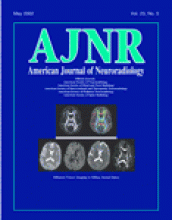Abstract
BACKGROUND AND PURPOSE: High signal intensity (HSI) at the pituitary stalk is reported in pituitary adenomas. Our purpose was to clarify how and when this HSI formed, its long-term fate, and its relation to the function of infundibuloneurohypophyseal (INH) system.
METHODS: Twenty-two patients with pituitary adenoma and supradiaphragmatic extension underwent 1.5-T MR imaging. Patients were assigned to two groups A (n = 18; those with stalk tip HSI) and B (n = 4; those without HSI) on postoperative T1-weighted images. Endocrine status was postoperatively evaluated and compared in both groups.
RESULTS: Group A patients did not have postoperative permanent diabetes insipidus (DI). Preoperative images in 17 patients revealed linear or ovoid HSI on the adenoma surface immediately above the diaphragma sellae. Of these, two with a poorly developed diaphragma sellae had HSI near the median eminence and inside the sella turcica. HSI was not apparent in the remaining patient with a giant, irregularly shaped adenoma. In group B, three patients had permanent DI. No patient had HSI on preoperative images.
CONCLUSION: Postoperative pituitary stalk HSI is derived from preoperative supradiaphragmatic HSI on the adenoma surface. The suspected mechanism is blockage of the hypophyseal-pituitary axis, with an accumulation of neurosecretory granules at the diaphragmatic level. Diaphragmatic shape may influence the location of HSI. The shape and location of HSI are essentially stable for years after surgery. No patients with permanent DI had HSI before or after surgery. HIS at the pituitary stalk tip is a useful landmark for predicting functional integrity of the INH system in patients with a large pituitary adenoma.
- Copyright © American Society of Neuroradiology












